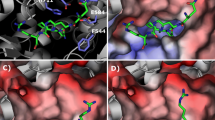Abstract
A major challenge in intranasal delivery of peptides is to overcome the enzymatic barrier that limits their absorption. Aminopeptidase inhibitors may be useful for improving systemic delivery of peptide drugs administered nasally. A phosphinic acid dipeptide analogue, a transition-state analogue aminopeptidase inhibitor in which the phosphinate moiety exists in a tetrahedral state mimicking peptides during their enzymatic hydrolysis, was synthesized and tested nasally in situ in rats. This inhibitor was found to inhibit greatly the degradation of the model peptide leucine-enkaphalin in the nasal perfusate at ≤2 µM concentrations. The nasal peptidase hydrolytic activity was reversible after exposure to the inhibitor. This inhibitor has the advantage of efficacy at very low concentrations and reversibility of effects.
Similar content being viewed by others
REFERENCES
M. A. Hussain, A. B. Shenvi, S. M. Rowe, and E. Shefter. The use of α-aminoboronic acid derivatives to stabilize peptide drugs during their intranasal absorption. Pharm. Res. 6:186–189 (1989).
M. A. Hussain, C. A. Koval, A. B. Shenvi, and B. J. Aungst. An aminoboronic acid derivative inhibits thymopentin metabolism by mucosal membrane aminopeptidases. Life Sci. 47:227–231 (1990).
M. A. Hussain, C. A. Koval, A. B. Shenvi, and B. J. Aungst. Recovery of rat nasal mucosa from the effects of aminopeptidase inhibitors. J. Pharm. Sci. 79:398–400 (1990).
P. P. Giannousis and P. A. Bartlett. Phosphorous amino acid analogues as inhibitors of leucine aminopeptidase. J. Med. Chem. 30:1603–1609 (1987).
E. K. Baylis, C. D. Campbell, and J. D. Dingwall. 1-Aminoalkylphosphonous acids. I. Isosteres of the protein amino acids. J. Chem. Soc. Perkin Trans. 1:2845–2853 (1984).
W. H. Parsons, A. A. Patchett, H. G. Bull, W. R. Schoen, D. Taub, J. Davidson, P. L. Combs, J. P. Springer, H. Gadebusch, B. Weissberger, M. E. Valiant, T. N. Mellin, and R. D. Busch. Phosphinic acid inhibitors of D-alanyl-D-alanine ligase. J. Med. Chem. 31:1772–1778 (1988).
R. E. Stratford and V. H. L. Lee. Aminopeptidase activity in homogenates of various absorptive mucosae in the albino rabbit: implications in peptide delivery. Int. J. Pharm. 30:73–82 (1986).
Author information
Authors and Affiliations
Rights and permissions
About this article
Cite this article
Hussain, M.A., Lim, M.S.L., Raghavan, K.S. et al. A Phosphinic Acid Dipeptide Analogue to Stabilize Peptide Drugs During Their Intranasal Absorption. Pharm Res 9, 626–628 (1992). https://doi.org/10.1023/A:1015845925668
Issue Date:
DOI: https://doi.org/10.1023/A:1015845925668




